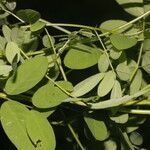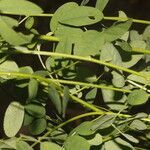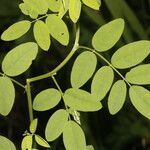Erect, annual or short-lived perennial herb, 0.15–0.45 m high; young stems ridged, green to grey, strigose with moderately dense to dense, appressed, equally biramous hairs. Leaves trifoliolate; stipules linear or narrow and triangular, (1.0–) 1.5–3 mm long, pubescent; petiole (1.5–) 4–10 (–15) mm long; rachis furrowed; stipellae absent; multicellular hairs between leaflet pairs inconspicuous, orange, pointed-linear; leaflets elliptic to obovate, (5–) 8–20 (–25) mm long, (2.0–) 2.5–7 (–10) mm wide, apex obtuse and shortly or inconspicuously mucronate, upper and lower surface green to grey, with moderately dense appressed hairs. Inflorescences (5–) 10–35 (–50) mm long, shorter than to longer than leaf; peduncle 0.5–3 (–5.0) mm long; bracts narrowly ovate, 0.5–1.5 mm long; pedicel 0.5–1 mm long; flowers dull or pale red. Calyx 2.5–5 mm long; lobes subequal, longer to much longer than the length of the tube and clothed with moderately dense, grey, appressed hairs. Standard elliptical to obovate, 5–6 mm long, 3.5–4.5 mm wide. Wings narrowly obovate to spathulate, 5–6 mm long, 1.5–2.3 mm wide. Keel 5–5.7 mm long, 1.5–2 mm deep; apex rounded; lateral pockets 0.5–0.9 mm long. Staminal tube 3–4 mm long, colourless. Ovary sparsely or moderately hairy. Pods spreading to descending, the pedicel strongly down-turned and the fruit standing out at a pronounced angle, with a longitudinal ridge along each side of the pod, giving a 4-angled appearance, (8–) 20–30 mm long, 2–3 mm wide, yellowish to pale brown, strigose; apex shortly beaked or pointed; endocarp not spotted; seeds 8–10 per fruit.
More
Foliolis ternatis ovatis acutis, racemis brevibus, caule erecto. Caulis erectus, viridis, facie I. Anil, inferne ramofus. Folia ternata, petiolata, ovata, lanceolata, acuta, viridia. Racemi laterales, foliis breviores, erecti, rubicundi, facie I. Anil.
Grassy localities, scrub, wastelands, savannah and open forests. It occurs in secondary vegetation, is a weed of disturbed ground and often invasive.
More
Recorded from a wide range of habitats: cracking clay, rich loamy or sandy soils on open plains or amongst rocks of various types on hills.
Can be grown by seedlings. Seeds needs soaking.




